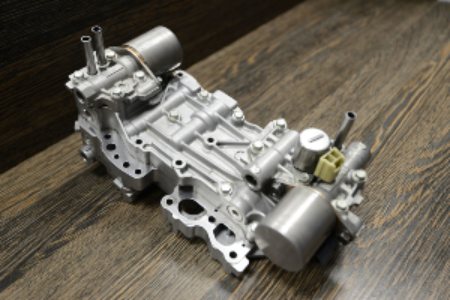| Toyota K CVT transmission | |
|---|---|
| Overview | |
| Manufacturer | Aisin |
| Also called | Super CVT-i |
| Production | 2000 - present |
The CVT gearbox, and variations thereof, has been around since the dawn of the motorcar, but it was the introduction of the Variomatic gearbox by Dutch car maker DAF in the 1950s that saw CVT. By: Lisa Bicknell Volunteers assisted with the clean-up at the Estill County Fairgrounds on Saturday, March 13. The fairgrounds were heavily damaged and the mud left behind on the grounds was a hindrance to clean-up. Animation explains the basic principle of CVTs (continuously variable transmission). Here, we look at the Va.
Toyota Motor Corporation's K series of CVTtransmissions found in many Toyota models. They are a pushbelt style of CVT manufactured by Aisin.

K110/K111/K112 series (2000)[edit]
K110[edit]
The K110 was Toyota's first belt-type CVT and production began in August 2000. Toyota said that the transmission was both fuel-efficient and offered high driving performance. The K110 features a torque converter with a long-travel damper to help achieve quiet operation and improved fuel efficiency.
Applications:
- Toyota Opa – 2.0L (2000–2005)
- Toyota Allion, Premio, Wish – 2.0L (2001–2011)
- Toyota Voxy – 2.0L (2007–2011)
- Toyota Auris & Corolla Axio / Fielder
- Toyota Ractis & Sienta
K111[edit]
The K111 transmission is an improved version of K110 introduced in July 2004. The K111 adds neutral-gear control and acceleration linear control.
Applications:
- Toyota Noah, Voxy – 2.0L (2004–2007)
K112[edit]
The K112 transmission, introduced in October 2005, is a modified version of the K111 that is built to work with higher displacement 2.4L engines.
Applications:
Cvt Transmission
- Toyota Alphard – 2.4L (2008–2017)
- Toyota Blade – 2.4L (2006–2011)
- Toyota Estima – 2.4L (2006–2017)
- Toyota Mark X Zio – 2.4L (2007–2011)
- Toyota RAV4 – 2.0/2.4/2.5L (2005–2011)
- Toyota Vanguard – 2.4L (2007–2011)
K120 'Direct Shift' transmission (2018)[edit]
Toyota brands the K120 as the Direct Shift-CVT and includes a physical first gear (also known as a 'launch gear') and nine additional simulated gears, for a total of 10. The launch gear is engaged when the car takes off from being stopped and transitions to the belt drive once the car picks up speed. The benefit of this system is that traditional CVTs tend to have low efficiency in lower gear ratios (creating a moment of sluggishness when starting from a stop).[1] Since belts are handling a more narrow band of gear ratios, belt angles and loads can be reduced, increasing shift speeds and offering a 6% improvement in fuel efficiency.[2] Production began in October 2018.
Applications:
- Toyota Corolla (E210) – 2.0L (2018–present)
- Toyota Camry (XV70) – 2.0L (2019–present)
- Toyota C-HR – 2.0L (2018–present)
- Toyota RAV4 (XA50) – 2.0L (2018–present)
- Toyota Yaris and Yaris Cross (2020-present)
K210 transmission (2002)[edit]
Achieve both high fuel efficiency and high powertrain performance through size and weight reductions and are perfect suited for vehicles in the 1.5- to 1.8-liter class. Production began December 2002. Later in February 2003 Toyota achieves fuel efficiency improvements through its Intelligent Idling Stop System developed by adding an electronic oil pump to the K210 belt-type CVT, ensuring excellent startup performance during engine restarts and producing class-leading fuel efficiency.

Applications:
K310/K311/K312/K313 series (2006)[edit]
Achieve both high fuel efficiency and high powertrain performance through size and weight reductions and are perfect suited for vehicles in the 1.5- to 1.8-liter class. Production began in September 2006.
Current applications:
- Toyota Corolla (K311), Altis – 1.8L (2010–present)
- Toyota Corolla Cross (K311) – 1.8L (2020–present)
- Toyota C-HR (K312) – 1.2L (2017–present)
- Toyota Vios (K312) – 1.5L (2016–present)
- Toyota Yaris (K312) – 1.5L (2016–present)
Previous applications:
- Toyota Auris, Corolla, Rumion – 1.5/1.8L (2006-2011)
- Toyota Allion, Premio – 1.5/1.8L, IST 1.5L (2007-2011)
- Toyota Avensis – 1.8/2.0L (2008-2011)
- Toyota Isis, Verso (K311), Wish – 1.8L (2009-2011)
- Toyota Probox, Succeed – 1.5L (2010-2011)
| Low | O/D | Rev |
|---|---|---|
| 2.386 | 0.411 | 2.505 |
Final drive:
- 5.698:1 (when fitted to 1.5L Allion & Premio 1NZ-FE and 1.8L Corolla 2ZR-FE)
- 5.356:1 (when fitted to 1.8L Allion & Premio 2ZR-FE)
K410/K411/K41 series (2004)[edit]
K411[edit]
Achieves both high fuel efficiency and high powertrain performance through size and weight reductions. Designed for vehicles with engine displacements between 1- and 1.3-liters. Production began December 2004.
Applications:

- Several other models
| Low | O/D | Rev |
|---|---|---|
| 2.4 | 0.43 | 2.505 |
Final drive:
- 5.833:1 (when fitted to 1L 1KR-FE)
- 5.08:1 (when fitted to 1.3L 1NR-FE)
K41A[edit]
A version of the K410 transmission with the differential shifted forward to maximize space the Toyota iQ, a compact city car that was engineered to maximize passenger space, while minimizing exterior length. Production began October 2008.
Applications:
K41B[edit]

Created by increasing the capacity of the K41A CVT, for 1.3-liter engines. Production began April 2009.
Applications:
K411[edit]
Based on the K410 and adopting a flex-start control mechanism for the first time in a Toyota CVT; Lock-up clutch actively activated during startup to run the engine in the most efficient operating region, thereby improving fuel efficiency. Production began December 2010.
Applications:
Cvtc Canvas
- Several models including Corolla, Auris, Vitz, Vios, Yaris, and Echo
See also[edit]
References[edit]
- ^Zatz, David (2018-03-23). 'Toyota's quiet transmission changes'. Retrieved 2020-09-17.
- ^'Direct Shift-CVT: A New Type of Continuously Variable Transmission'. Toyota Motor Corporation Official Global Website (Press release). 2018-02-26. Retrieved 2020-09-17.
Cvt Transmission Problems
